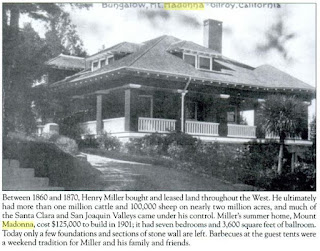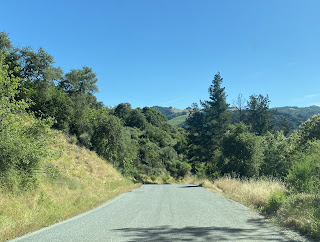The origin of Gilroy date back to Alta California and the arrival of Scotsman John Gilroy. John Gilroy was a crew member of armed merchant ship Issac Todd which was sent by the North West Company during the War of 1812 to capture American Fort Astoria. The Issac Todd arrived in the Spanish port of Monterey in January of 1814 where John Gilroy was either left behind or jumped ship to recover from Scurvy.
John Gilroy was a barrel maker and spent the next several years plying his trade in northern Alta California. John Gilroy eventually came to Rancho San Ysidro (which was on the Spanish El Camino Real) where he converted to Catholicism and became the first English speaking naturalized citizen of Alta California. In 1821 (the same year the Mexican's won independence from Spain) John Gilroy married Maria Clara who was the daughter of rancher Ygnacio Ortega. Upon the death of Ygnacio Ortega in 1833 Rancho San Ysidro was divided up between his three children. Following the Mexican-American War of 1848 the property rights to Rancho San Ysidro were granted to John Gilroy.
John Gilroy's property would soon grow into a town bearing his name. Given the close proximity of Gilroy to Pacheco Pass it became a stop on the Butterfield Overland Mail route from 1858 to 1861. In 1868 Gilroy incorporated as a town and successfully lobbied to become a stop on the new Southern Pacific Railroad Line. The core of Gilroy was relocated westward to where the Southern Pacific Railroad would pass by, and the original town core came to be known as Old Gilroy. The Southern Pacific reached Gilroy by 1869 and was reincorporated as a city in March of 1870.
During the period of Mexican Alta California, the area that is now Watsonville became Rancho Bolsa del Pajaro. Rancho Bolsa del Pajaro was granted in 1837 to Sebastian Rodriguez. The area was attractive to numerous American settlers due to it being close proximity to the fertile fields north of the Pajaro River.
Rancho Bolsa del Pajaro was sold in 1852 to San Francisco district judge John Watson. Following the purchase, Watson would resign his position and plot the town site of Watsonville on his new land holdings. Watsonville would incorporate as a town on March 30, 1868.
The 1876 Thompson & West Atlas of Santa Cruz County depicts Watsonville Road crossing Mount Madonna west of Gilroy. Watsonville Road is seen crossing through Solis Rancho and climbing to the Santa Cruz County line in Township 10S, Range 2E.
Watsonville Road can be seen connecting Watsonville-Gilroy via Mount Madonna on the 1882 Bancroft's Map of California.
In 1875 (visitgilroy.com) rancher Henry Miller would purchase 13,000 acres of land atop Mount Madonna as a summer retreat. During the late nineteenth century, much of the old growth Coast Redwoods were logged at the Miller property. In 1901 Miller would construct a summer home at Mount Madonna near Watsonville Road (South Santa Clara County by Sam Shueh).
Following the 1906 San Francisco Earthquake logging at Mount Madonna would cease on the Miller property. During the early automotive era the use of Watsonville Road as a primary highway was becoming increasingly problematic. The roadway was narrow and carried grades as high grades near the summit.
Watsonville Road over Mount Madonna is shown as the primary automotive highway between Watsonville-Gilroy on the 1917 California State Automobile Association map. Watsonville was not served by the State Highway System until Legislative Route Number 67 (now California State Route 129) was defined in 1921 through the Chittenden Pass corridor.
A portion of Miller's estate would be acquired by Santa Clara County in 1927 (visitgilroy.org) to form Mount Madonna Park. During the late 1920s Santa Cruz County and Santa Clara County would construct Hecker Pass Highway between Watsonville-Gilroy in the Santa Cruz Mountains. The new highway was dedicated on March 27, 1928 (South Santa Clara County by Sam Shueh).
In 1933 Hecker Pass Highway would be added to the State Highway System as an extension of Legislative Route Number 32 west of Gilroy. The corridor was assigned as part of California State Route 152 when the initial run of Sign State Routes was announced in the August 1934 California Highways & Public Works.






























































































Comments